|
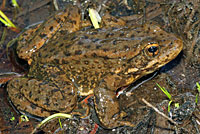 |
 |
 |
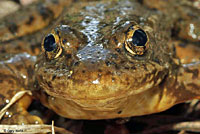 |
| |
Adult male, Alpine County |
|
 |
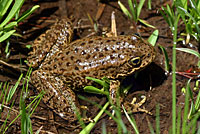 |
 |
 |
| Adult, Alpine County |
Adult, Alpine County |
Adult, Alpine County |
Adult, Alpine County |
 |
 |
 |
 |
| Adult, Alpine County |
Adult, Alpine County |
Adult, Alpine County |
Adult, Alpine County |
 |
 |
 |
 |
| Adult male, Alpine County |
Adult, Alpine County |
Adult, Alpine County |
Juvenile, Alpine County |
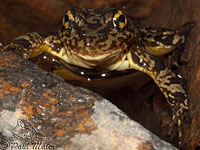 |
 |
 |
 |
| Mottled adult, Fresno County © Paul Maier |
Underside of adult showing yellow legs, Alpine County |
Adult underside, Inyo County
© Todd Battey |
 |
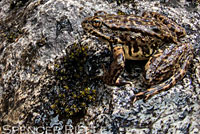 |
 |
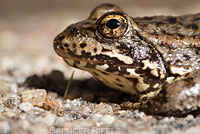 |
Adult, 11,100 ft., Mono County
© Chris Lima |
Adult, Amador County
© Spencer Riffle |
Adult, Fresno County
© Spencer Riffle |
Adult, Fresno County
© Spencer Riffle |
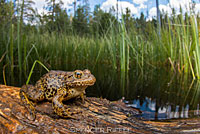 |
 |
 |
 |
Adult, Sierra County
© Spencer Riffle |
Adult, Sierra County
© Spencer Riffle |
Adult, Sierra County
© Spencer Riffle |
Congregation of adult frogs, Fresno County. These frogs were discovered on the south-facing slope of a barely ice-free alpine lake (11,000 ft.). They are covered with pollen, wind-blown from lower altitudes, which coated the area.
© Ceal Klingler |
 |
 |
 |
 |
Once thought to only inhabit high elevation lakes without fish, these Sierra Nevada Yellow-legged Frogs are seen utilizing suitable habitats found in and around
high-elevation fast-flowing Sierra Nevada streams in Plumas County. © Neil Keung |
 |
 |
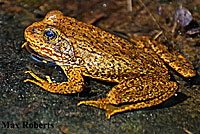 |
 |
| Adult, Tuolumne County © John Hodgson |
Yellow adult, Tuolumne County
© Max Roberts |
Adult with an unusual pigment condition, possibly leucism or it might be piebald, Fresno County © Isaac Chellman |
| |
|
|
|
| Reproduction, Eggs and Tadpoles |
 |
 |
 |
|
| Calling adult male, Alpine County |
Adults in amplexus, Alpine County |
Eggs |
Mature Tadpole |
More pictures of breeding, eggs, tadpoles, and breeding habitat can be seen here.
|
| Predation |
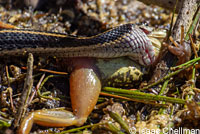 |
 |
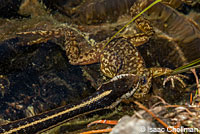 |
 |
 |
 |
 |
|
| The pictures above show a Mountain Gartersnake discovered by Spencer Williams that is preying on a juvenile Sierra Nevada Yellow-legged Frog in Eldorado County. The last picture shows the frog being swallowed head first. © Isaac Chellman |
| |
|
|
|
| Habitat |
 |
 |
 |
 |
| Habitat, Alpine County |
Habitat, 8,800 ft., Alpine County |
Habitat, 8,800 ft., Alpine County |
Habitat, Mono County |
 |
 |
 |
 |
Habitat, Fresno County
© Vance Vredenburg
|
Habitat, Inyo County © Todd Battey |
Habitat, Fresno County
© Spencer Riffle |
Habitat, Tuolumne County
© Max Roberts |
| |
|
|
|
| Short Videos |
 |
 |
 |
 |
| These are four videos of three different male frogs calling during an early summer afternoon in Alpine County. Running water, birds, insects, and an occasional Pacific Treefrog are heard in the background. |
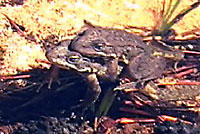 |
 |
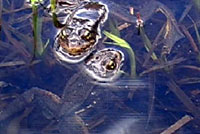 |
 |
| Several pairs of male and female frogs in amplexus are seen in this video with attempts by other males to steal the females. They are successfully fought off by the amplexing males, usually by a strong kick, but sometimes a long wrestling match ensues. |
Several groups of male frogs are seen during the breeding season chasing and amplexing each other. You can hear release calls in the first few scenes. This behavior continued for hours, so it did not appear that they were mistaking each other for females they could breed with, but that it was some kind of territorial behavior between males. Or they could have been practicing their pouncing skills for when they encountered females in the future. (This is a long video which might take some time to download.) |
Two males are seen during the breeding season chasing and amplexing each other until one leaves and the other begins calling. |
This is a long (2 minute) version of a frog calling in the afternoon Alpine County. |
|
|
|
|
| Description |
| |
| Size |
Adults are moderate in size, 2 - 3 inches long from snout to vent (5 - 7.6 cm). (Stebbins & McGinnis, 2012)
|
|
| Appearance |
A medium-sized frog with a slim waist, long legs, smooth skin and webbing on the hind feet.
Ridges on the sides (dorsolateral folds) are not distinct.
|
| Similar Species |
Differs from Rana muscosa by having relatively shorter legs and a significantly different mating call.
When it is extended forward, the heel of the hind foot of Rana sierrae usually does not reach the nostril. The heel of Rana muscosa does reach the nostril.
|
| Color and Pattern |
Variable in color - olive, yellowish or brown above, with varying amounts of black or brown markings.
Pale orange to yellow below and underneath the hind legs.
No dark face mask is present. |
| Larvae (Tadpoles) |
Tadpoles grow up to 2 inches in length (5 cm.)
Coloring is brown with a tint of gold and dark spots.
|
|
| Comparing Red-legged Frogs and Yellow-legged Frogs and Bullfrogs |
| |
| Life History and Behavior |
| Activity |
A mountain frog of high elevations.
Chiefly diurnal.
Usually found in or very close to water, typically within a couple of meters (two or three jumps away from water.)
Rarely occurs where predatory fishes have been introduced.
Adults and tadpoles often spend the winter at the bottom of frozen lakes. Adults may die under ice in winter due to low oxygen levels. Tadpoles are more tolerant of low oxygen levels.
Emerges shortly after snow melts.
In years of heavy snow and a long period of freezing temperatures, may only be active for about 3 months.
Smells like garlic when handled. |
| Longevity |
| Not known. |
| Voice (Listen) |
| The call is a short and rasping call often accelerated and rising at the end, sometimes preceded by calls that don't rise at the end. Calls primarily underwater during the day, but may also call at night. This frog has no vocal sacs, so the call has very little volume. |
| Diet and Feeding |
Eats a variety of terrestrial and aquatic invertebrates and tadpoles.
May also consume dead frogs and its own eggs.
Frogs tend to sit and wait until they see prey come within range, then they strike, or creep up a little then strike, using their large sticky tongue to catch the prey and bring it into the mouth. |
| Reproduction |
Reproduction is aquatic.
Fertilization is external, with the male grasping the back of the female and releasing sperm as the female lays her eggs.
The reproductive cycle is similar to that of most North American Frogs and Toads. Mature adults come into breeding condition and the males call to advertise their fitness to competing males and to females. Males and females pair up in amplexus in the water where the female lays her eggs as the male fertilizes them externally. The eggs hatch into tadpoles which feed in the water and eventually grow four legs, lose their tails and emerge onto land where they disperse into the surrounding territory.
Mating and egg-laying occurs in water shortly after the snows have melted and adults have emerged from hibernation, which can be any time from May - August.
Adults tend to live around the breeding pond, so most do not need to travel to the breeding site.
|
| Eggs |
A cluster of 100 - 350 eggs (average 233) is laid in shallow water and is left unattached in still waters, but may be attached to vegetation in flowing water.
Egg-laying sites must be connected to permanent lakes or ponds that do not freeze to the bottom in winter, because the tadpoles must live in the water over winter.
|
| Tadpoles and Young |
Tadpoles overwinter, possibly taking as many as 3 or 4 summers before they transform.
|
|
| Habitat |
Inhabits lakes, ponds, meadow streams, isolated pools, and sunny riverbanks in the Sierra Nevada Mountains.
Usually found in or very close to water, typically within a couple of meters (two or three jumps away from water.)
Highly adaptable in regards to what perching conditions (i.e., slope, canopy, cover, substrate) are available.
Once thought to only inhabit high elevation lakes without fish, recent research (2019) has shown that this species readily occupies streams, both perennial and intermittent, as well. Frogs will utilize slow pockets of water in fast-flowing streams.
"Seems to prefer sloping banks with rocks or vegetation to water's edge." (Stebbins 2003)
Waters that do not freeze to the bottom and which do not dry up completely are required.
(If a body of water used for breeding dries up for just one season, 3 - 4 generations of tadpoles will be destroyed.)
|
|
| Geographical Range |
| Historically, Rana sierrae ranged "...from the Diamond Mountains north-east of the Sierra Nevada in Plumas County, California, south through the Sierra Nevada to the type locality, the southern-most locality (Inyo County). In the extreme north-west region of the Sierra Nevada, several populations occur just north of the Feather River, and to the east, there was a population on Mt Rose, north-east of Lake Tahoe in Washoe County, Nevada, but it is now extinct. West of the Sierra Nevada crest, the southern part of the R. sierrae range is bordered by ridges that divide the Middle and South Fork of the Kings River, ranging from Mather Pass to the Monarch Divide. East of the Sierra Nevada crest, R. sierrae occurs in the Glass Mountains just south of Mono Lake (Mono County) and along the east slope of the Sierra Nevada south to the type locality at Matlock Lake (Inyo County)." (Vredenburg, et al, 2007.) |
| Elevational Range |
From 984 ft. to over 12,000 ft. elevation (370 - 3,660 m.)
|
|
| Notes on Taxonomy |
According to a February, 2008 petition by the Center for Biological Diversity and Pacific Rivers Council to list the Sierra Nevada Mountain Yellow-legged Frog as an Endangered Species, "The mountain yellow-legged frog in the Sierra Nevada is geographically, morphologically and genetically distinct from mountain yellow legged frogs in southern California. It is undisputedly a 'species' under the ESAOs listing criteria and warrants recognition as such."
Vredenburg, V. T., R. Bingham, R. Knapp, J. A. T. Morgan, C. Moritz & D. Wake (2007. Journal of Zoology 271: 361–374) have determined that this taxon consists of two species, which they name Rana muscosa - Sierra Madre Yellow-legged Frog, and Rana sierrae - Sierra Nevada Yellow-legged Frog. More from the CNAH.
In 2008, the Society for the Study of Amphibians and Reptiles recognized two species, Rana muscosa - Southern Mountain Yellow-legged Frog , and Rana sierrae - Sierra Nevada Yellow-legged Frog.
Alternate and Previous Names (Synonyms)
Rana muscosa - Mountain Yellow-legged Frog (Stebbins 1966, 1985, 2003)
Rana boylii sierrae (Stebbins 1954)
Rana boylii sierrae - Sierra Nevada Yellow-legged Frog (Western Frog, Pacific Frog, Stink Frog) (Wright & Wright 1949)
Rana boylii muscosa - Sierra Nevada Yellow-legged Frog (Storer 1925)
Rana boylii sierrae - Sierra Nevada Yellow-legged Frog - Western Frog, Pacific Frog (Rana aurora, part; Rana pretiosa, part; Rana temporaria pretiosa, part)
(Grinnell and Camp 1917)
|
|
| Conservation Issues (Conservation Status) |
Endangered and absent from a significant part of its historic range. The decline has been attributed to many factors, including introduced non-native trout, airborne pollution, insufficient snowmelt to fill breeding ponds brought about by climate change, cattle grazing, ozone depletion, pollution from mining, public dumping, and chytrid fungus. Fish introductions have stopped in some areas, such as National Parkland, they continue in others. But while it has been documented that introduced trout are substantially reducing the numbers of the frogs, frogs have also disappeared in one watershed where no trout have been introduced, which suggests multiple causes for their decline.
Researchers have discovered protective bacteria on the skin of wild frogs that have survived the chytrid fungus which they have recreated in the lab and used to kill the fungus. Experiments by Vance Vredenburg with wild frogs have shown some success - a 2011 survey found that the only surviving frogs at one location were those that had been treated with the bacteria in 2010.
Proposed for Federally Endangered listing 4/25/13.
Federally Protected under the Endangered Species Act 4/25/14.
In August, 2016, the U.S. Fish and Wildlife Service announced the designation of 1.8 million acres of protected critical habitat in the Sierra Nevada mountains for Rana sierrae, the Sierra Nevada Yellow-legged Frog, the northern population of Rana muscosa, the Southern Mountain Yellow-legged Frog, and Anaxyrus canorus, the Yosemite Toad. BiologicalDiversity.org |
|
| Taxonomy |
| Family |
Ranidae |
True Frogs |
Rafinesque, 1814 |
| Genus |
Rana |
True Frogs |
Linnaeus, 1758 |
| Species |
sierrae |
Sierra Nevada Yellow-legged Frog
|
Camp, 1917 |
|
Original Description |
Rana muscosa: Camp, 1917 - Univ. California Publ. Zool., Vol. 17, No. 9, p. 118
from Original Description Citations for the Reptiles and Amphibians of North America © Ellin Beltz
Rana sierrae:
Vredenburg, V. T., R. Bingham, R. Knapp, J. A. T. Morgan, C. Moritz & D. Wake (2007. Journal of Zoology 271: 361–374)
|
|
Meaning of the Scientific Name |
Rana - Latin = frog - probably mimics how the Romans heard their call
sierrae - refers to the Sierra Nevada Mountains
Taken in part from Scientific and Common Names of the Reptiles and Amphibians of North America - Explained © Ellin Beltz
|
|
Related or Similar California Frogs |
Rana aurora
Rana boylii
Rana cascadae
Lithobates catesbeiana
Rana draytonii
Rana muscosa
Lithobates pipiens
Rana pretiosa
Lithobates yavapaiensis
|
|
More Information and References |
California Department of Fish and Wildlife
AmphibiaWeb
Center for Biological Diversity
Dr. Roland Knapp's site
Rescuing a Dying Breed - Saving the Southern California Mountain Yellow-legged Frog
The Mountain Yellow-legged Frog - Can They Be Saved?
Hansen, Robert W. and Shedd, Jackson D. California Amphibians and Reptiles. (Princeton Field Guides.) Princeton University Press, 2025.
Stebbins, Robert C., and McGinnis, Samuel M. Field Guide to Amphibians and Reptiles of California: Revised Edition (California Natural History Guides) University of California Press, 2012.
Stebbins, Robert C. California Amphibians and Reptiles. The University of California Press, 1972.
Flaxington, William C. Amphibians and Reptiles of California: Field Observations, Distribution, and Natural History. Fieldnotes Press, Anaheim, California, 2021.
Nicholson, K. E. (ed.). 2025. Scientific and Standard English Names of Amphibians and Reptiles of North America North of Mexico, with Comments Regarding Confidence in Our Understanding. Ninth Edition. Society for the Study of Amphibians and Reptiles. [SSAR] 87pp.
Samuel M. McGinnis and Robert C. Stebbins. Peterson Field Guide to Western Reptiles & Amphibians. 4th Edition. Houghton Mifflin Harcourt Publishing Company, 2018.
Stebbins, Robert C. A Field Guide to Western Reptiles and Amphibians. 3rd Edition. Houghton Mifflin Company, 2003.
Behler, John L., and F. Wayne King. The Audubon Society Field Guide to North American Reptiles and Amphibians. Alfred A. Knopf, 1992.
Robert Powell, Roger Conant, and Joseph T. Collins. Peterson Field Guide to Reptiles and Amphibians of Eastern and Central North America. Fourth Edition. Houghton Mifflin Harcourt, 2016.
Powell, Robert., Joseph T. Collins, and Errol D. Hooper Jr. A Key to Amphibians and Reptiles of the Continental United States and Canada. The University Press of Kansas, 1998.
American Museum of Natural History - Amphibian Species of the World 6.2
Bartlett, R. D. & Patricia P. Bartlett. Guide and Reference to the Amphibians of Western North America (North of Mexico) and Hawaii. University Press of Florida, 2009.
Elliott, Lang, Carl Gerhardt, and Carlos Davidson. Frogs and Toads of North America, a Comprehensive Guide to their Identification, Behavior, and Calls. Houghton Mifflin Harcourt, 2009.
Lannoo, Michael (Editor). Amphibian Declines: The Conservation Status of United States Species. University of California Press, June 2005.
Storer, Tracy I. A Synopsis of the Amphibia of California. University of California Press Berkeley, California 1925.
Wright, Albert Hazen and Anna Wright. Handbook of Frogs and Toads of the United States and Canada. Cornell University Press, 1949.
Basey, Harold E. Discovering Sierra Reptiles and Amphibians. Yosemite Association and Sequoia Natural History Association, 1976, 1991.
Davidson, Carlos. Booklet to the CD Frog and Toad Calls of the Pacific Coast - Vanishing Voices. Cornell Laboratory of Ornithology, 1995.
Vredenburg, V. T., R. Bingham, R. Knapp, J. A. T. Morgan, C. Moritz & D. Wake (2007. Journal of Zoology 271: 361–374)
Joseph Grinnell and Charles Lewis Camp. A Distributional List of the Amphibians and Reptiles of California. University of California Publications in Zoology Vol. 17, No. 10, pp. 127-208. July 11, 1917.
|
|
|
The following conservation status listings for this animal are taken from the July 2025 State of California Special Animals List and the July 2025 Federally Listed Endangered and Threatened Animals of California list (unless indicated otherwise below.) Both lists are produced by multiple agencies every year, and sometimes more than once per year, so the conservation status listing information found below might not be from the most recent lists, but they don't change a great deal from year to year.. To make sure you are seeing the most recent listings, go to this California Department of Fish and Wildlife web page where you can search for and download both lists:
https://www.wildlife.ca.gov/Data/CNDDB/Plants-and-Animals.
A detailed explanation of the meaning of the status listing symbols can be found at the beginning of the two lists. For quick reference, I have included them on my Special Status Information page.
If no status is listed here, the animal is not included on either list. This most likely indicates that there are no serious conservation concerns for the animal. To find out more about an animal's status you can also go to the NatureServe and IUCN websites to check their rankings.
Check the current California Department of Fish and Wildlife sport fishing regulations to find out if this animal can be legally pursued and handled or collected with possession of a current fishing license. You can also look at the summary of the sport fishing regulations as they apply only to reptiles and amphibians that has been made for this website.
Special Animals List Notes:
Formerly Rana muscosa. Rana muscosa was split into Rana sierrae, the Sierra Nevada yellow-legged frog, found in the northern and central Sierra Nevada, and Rana muscosa, the southern mountain yellow-legged frog, found in the southern Sierra Nevada and southern California.
|
| Organization |
Status Listing |
Notes |
| NatureServe Global Ranking |
G1 |
Critically Imperiled |
| NatureServe State Ranking |
S1 |
Critically Imperiled |
| U.S. Endangered Species Act (ESA) |
FE |
Listed as Endangered 6/30/2014 |
| California Endangered Species Act (CESA) |
ST |
Listed as Threatened 4/1/2013 |
| California Department of Fish and Wildlife |
WL |
Watch List |
| Bureau of Land Management |
None |
|
| USDA Forest Service |
S |
Sensitive |
| IUCN |
EN |
Endangered |
|
|
|

































































